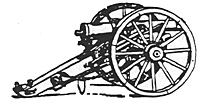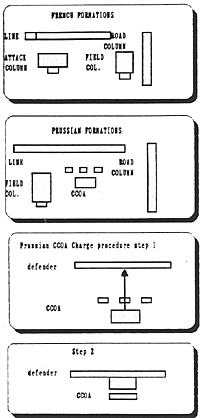 This article is a summery of the modifications that I have come up with to date and including a number of suggestions from Steve Verdoliva. I have done a number of test games with these modifications and they seem to work well. For those who are interested in getting a copy of the modified charts for this write me at the address for the newsletters.
This article is a summery of the modifications that I have come up with to date and including a number of suggestions from Steve Verdoliva. I have done a number of test games with these modifications and they seem to work well. For those who are interested in getting a copy of the modified charts for this write me at the address for the newsletters.
The first modification is that of the stand / figure scale, due to the large size of the forces that partook in the Franca Prussian War each stand now is equivalent to 300 ten. The maneuver elements are regiments - not brigades (these regiments were generally larger than ACV brigades!). Each, artillery stand now represents 12 guns (i.e. two batteries). The ground scale is 1": 100 yards (actually 90 but 100 will be easier to work with). the stand sizes for infantry and cavalry stay the same.
For artillery however, use the following. Artillery: 2' wide by 1.5' deep (or what ever it takes to get the guns to fit) with 2 - 3 crew figures. French Nitrailleuses will be mounted an a 1' frontage (this represents one battery of 6 weapons, and a damaged battery result means the battery is removed from play). In Fire & Fury they state the guns should be up to 2' wide for 8 guns i.e. 120 yards. I feel that a 200 yard frontage for 12 guns is about right i.e. 16 - 17 yards per gun. There is no need for dismounted cavalry - both sides did not use any of their cavalry in this manner except for patrols and or some skirmishing (never ever in a formal battle). Yes they still believed MASSED cavalry had a role on the battlefield! Command control ranges are now 12' for both corps and divisions and 6' for Prussian brigade commanders (Yes the Prussians get brigade commanders the French do not).
Weapon ranges are more varied, the French and Prussians now each have a separate chart . The additional fire effects and modifiers help to reflect some of the tactical adaptations to the breechloader. The optional French modifier for 11-13" range is due to information that the French would fire as a battalion from the hip with a high trajectory at long range targets creating a "beaten zone" of fire. To get the bonus there must be at least 3 stands of infantry shooting at the 11-13" range.
The Prussians reported that this fire could be very effective against their massed company columns. Entrenching was much more common from the outset in this war (mostly with the French) - yes the generals recognized the power of the breechloading rifle (the infantry generals anyway!). To get the entrenched bonus more than half of the firing stands must be in trenches. The addition of forcing units to go prone is also a reflection of what happened time and time again as units would come under heavy fire. You may want to add a -1 to a unit's die roll for maneuver if prone (once units hit the dirt it was such harder to get them moving forward again).
 The formation limitations are needed to reflect the differences in tactical doctrine. The line was favored for defense while attack columns (French) and company columns of attack - CCOA -(Prussians) were used to enable the formations to get at the enemy. Both sides may sill use the supported line and field column (at basic movement rate). Both the French attack column and Prussian CCOA use the attack col, movement rate.
The formation limitations are needed to reflect the differences in tactical doctrine. The line was favored for defense while attack columns (French) and company columns of attack - CCOA -(Prussians) were used to enable the formations to get at the enemy. Both sides may sill use the supported line and field column (at basic movement rate). Both the French attack column and Prussian CCOA use the attack col, movement rate.
There is a new category on the maneuver table under good ordered effects, this is Impetuous. Units that roll 13 or higher and that have visible enemy units within 12' of them will apply this result. The exceptions being; units in trenches treat as well handled. The movement table modifiers reflect the inertia of the French higher command levels as well as the Prussian imitation of the ' Furia Franca' (which the French now did not feel prudent to employ ) and the 'lets get at them' mentality of overall officer corps of the Prussian Army (the Bavarians were noticeably lacking in this 'spirit' while the Saxons and Vurt. were more level headed). It should be noted that commander benefits must be applied and player(s) should not deliberately keep all their units out of command control range (12" and 6") to avoid this! So a commander must have at least one of the units in his chain of command in range at all times (excluding artillery). The chain of command setup will benefit the Prussians once his units are disordered or spent but will cause premature commitment to combat unless care is taken. The French will be Ot early on but as their units suffer they will not have a tremendous ability to get things done.
The ammo resupply rules are unchanged - also this means the Prussians will have to move further back to resupply.
Line of sight through woods and towns is now 1.5". Units may voluntarily go prone or be forced prone by fire effects. If done so voluntarily the unit must be in line formation and may be done at the end of movement at no cost. If a fire result caused the unit to go prone, the unit immediately has a prone counter placed by it in its current location. Units behind works in trenches or in towns do not roll for prone unless they are in a town and attempting to charge hose. To stand back up the unit does the following, must have received a rally with elan or well handled on the maneuver table and will have 1/2 move. If a rally or tardy was the result it may stand up but not move. Any other result results in the unit staying prone. If the result calls for a retrograde movement the unit will be moved but is still prone after movement.
Prussian CCOA are handled in the following manner. When a player wishes to charge with a CCOA he moves the unit into contact with the target formation, as he does this the stands that were skirmishing now fall back and form the third rank. When calculating the charge the third rank is not counted for numbers on the first round, if there are additional rounds (i.e. a desperate struggle or breakthrough) they do count. As long as the skirmishing stands would have been able to contact the target unit the whole unit is considered in distance. If the unit receives a breakthrough the formation will retain its column formation as 3 x 3 or as evenly as the number of stands allow in all subsequent charge resolutions for the current turn. Note that the skirmish stands say not fire during the charge. If the Prussian player was unable to contact the target unit and in any other situation for normal fire, only the skirsishing stands say fire.
If fired on and the formation is at a range of 10" or less the skirsishing stands are the only valid target unless the firing unit is above the CCOA. At over 10" range the forged part of the CCOA is the target (if using the optional 11-13" range modifier for the French this means a +2 die roll in addition to anything else that sight apply - +1 for target in column and +1 for CCOA at 11-13" range).
When a CCOA is the target of a charge the skirmish stands are placed behind the column as a third rank and say participate after the 1st round of charge combat as above. Note: for the unit's defensive fire both the formed stands and the skirmish stands may fire, the formed as formed, the skirmish as skirmishers. Additionally the CCOA does not get the +1 modifier if it is defending.
One additional step is added to the charge procedure. When an attacking enemy unit gets to within 2 inches of the defender it is stopped and marked with a charge marker. During the fire phase it takes defensive fire, if it does not go prone it is moved into contact with the defender. The attacker may then conduct normal fire for a charging unit. Note also that the defender gets all modifiers during it's fire as if the attacker had contacted it. Also units involved in a charge and defending and take fire loses do not roll for going prone. If the attacker fails to contact and goes prone it issues fire during the appropriate phase in it's new formation. Finally if a defender is prone when attacked it will stand up automatically and issue defensive fire but still applies the prone modifiers for it's fire and during the charge resolution (first round only).
A couple of final notes, first if the defender in a charge is completely artillery and gets a swept from the field result all guns are captured, Second, there is a rule conflict within Fire and Fury dealing with Disordered units the rule on page 29 and the Disordered Effects table Broken result. The rule states that any disordered unit that has to execute a full retreat is removed from play. This makes no sense with the Broken result on the table. So, for our gases we ignore the rule for the retreat effect and go by the table (only when rolling for Maneuver!). Finally a clarification, when a unit loses a charge and must retreat back 1.S' it oust be this distance from the final position of the winner (i.e. if he occupies ground). The last part of this article are the diagrams shoving the formations.
Back to Table of Contents The Messenger February 1994
Back to The Messenger List of Issues
Back to MagWeb Magazine List
© Copyright 1994 by HMGS/PSW.
This article appears in MagWeb.com (Magazine Web) on the Internet World Wide Web.
Other articles from military history and related magazines are available at http://www.magweb.com